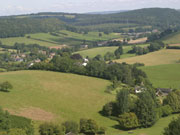 |
 |
 |
 |
As a relative newcomer to Hope Mansell I have become increasingly interested in the history of this fairly hidden valley. My appetite was further whetted by the conundrum of one L or two. I was told in no uncertain terms, soon after arriving here, that any reference to St Michael's Church should only ever have one L, so being of an inquiring (and somewhat stubborn) nature I decided to investigate the reason for this. I hasten to add that I am not sure whether all of these facts are correct, and I would be interested in hearing from anyone who can give me more information, but this is what I have been able to discover.
Hope Mansell is mentioned in the Domesday Book, where it is referred to as 'Hope' (the old English word for valley), and was held as two manors (a manor was the holding of a feudal lord at the time) by Leofric and Edwulf before the Conquest. The manor was then held from the King (William the Conqueror) by William Fitz (or son of) Baderon, and was assessed for tax purposes at 40 shillings. William received many grants of land and manors from William the Conqueror after the Battle of Hastings, and until the family line died out in 1377 due to the black plague, they held land from Monmouth, across the Forest of Dean to the River Severn. I doubt he ever came to Hope Mansell, and in fact the manor, and that of Ruardean are recorded as being leased to Saloman, a Breton. A third of the land was in the hands of St Peter's Church, Gloucester (later to become Gloucester Cathedral), and while the lord of the manor had two ploughs*, there was one villager+ with land, a smallholder# with one and a half ploughs, and '4 hides which pay tax' (a hide was the land supporting one family, usually about 120 acres). Villages were originally medieval administration units, and it was only after 1597 that ecclesiastical units were separated from civil parishes, so the concept of the church parish came into being.
The Mansell part of the name is first mentioned in The Book of Fees which contains a reference of 1242-3 to the vill of Hope Mal Oysel, and the earliest recorded incumbent for Hope Maloisel, John de Werden, was presented the living of the church in 1246, although there is an earlier reference to Henry Maloisel in an item concerning Goodrich Castle, which appears in 1186. In 1285 Henry le Duc of Hope Maloysel was pardoned for participating in a group who captured and decapitated Philip de Blakeneye, who had trespassed in the Dene Forest. Having been taken, De Blakeneye escaped to commit futher trespasses and robberies. Then, Henry le Duc and others are said to have pursued "him with hue and cry as one fleeing from justice, (and) decapitated him." The village was then variously called Hope-Maloysell (1263), Maleyshall (1338), Maloisel (1367) and Meleishulle, and in 1545 it was referred to as "Hope Maleysell alias Manselle Hope" in Diocese of Hereford: Institutions, etc. AD 1539-1900. In the 16th century it was also referred to as Hope Maynesell or Mauncells Hopp, but with very few people able to read and write during this period of history, spelling was a fairly flexible art!
In the 17th Century, 'Hope Mauncell' is listed in the register of parish returns towards the rebuilding of St Paul's Cathedral around 1678 (after the Great Fire of course). Records survive from about 3300 parishes, townships, and hamlets, which list sums of money collected in each area, in some cases with the donor's names. The records are held in the Guildhall Library Manuscripts Section, and the next time I am in London I will try to find out how much was donated. Weston under Penyard also contributed!
Littlebury's Directory & Gazeteer of Herefordshire 1876-7 lists the village as Hope Mansel or Manell (sic). There are even references to Hope Mellishall in the 1890's. A poster advertising the sale of Street Farm in 1894, however, uses Hope Mansell, and interestingly, at this time there were "two deliveries daily" to the village post office! Maps are just as varied. While the Ordnance Survey maps of 1840 and 1891 used one L, Ordnance Survey now use two, but a map of Herefordshire, which I believe dates from 1832 also uses two Ls!
So now I am totally confused, but it really seems that it does not matter whether you use one L or two!
Caroline Elmitt
With thanks to Sheila Dewdney who allowed me to use the information she researched for her history of Hope Mansel Church
* The standard Domesday plough team was drawn by eight oxen. This standard team was the theoretical basis for the units of assessment in Domesday Book. The standard Domesday plough team could notionally plough 120 acres in an agricultural year, so a "plough" in this context was a nominal 120 acres.
+ Villagers formed the largest group among the peasantry, over 40% of the recorded population in Domesday Book. They were the most substantial group among the unfree peasantry, possessing on average 30 acres of land and two plough oxen.
# Smallholders formed the second largest group among the peasantry, constituting almost a third of the recorded population. On average, they possessed 5 acres of land and might have a share in the villagers' plough teams, though their holdings could be more meagre.